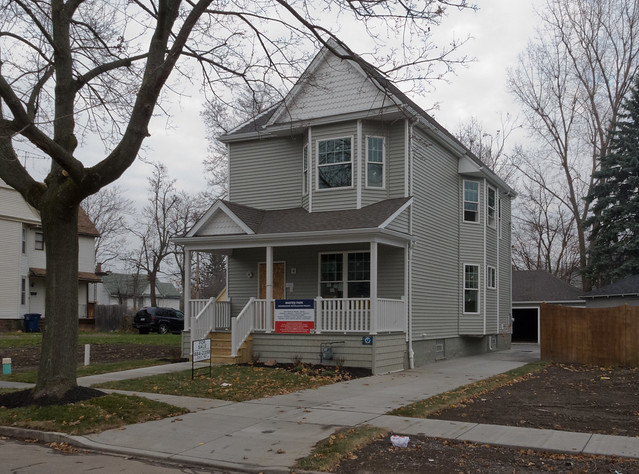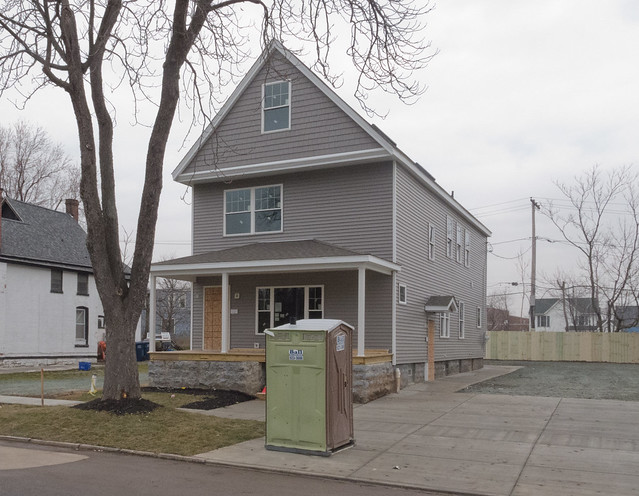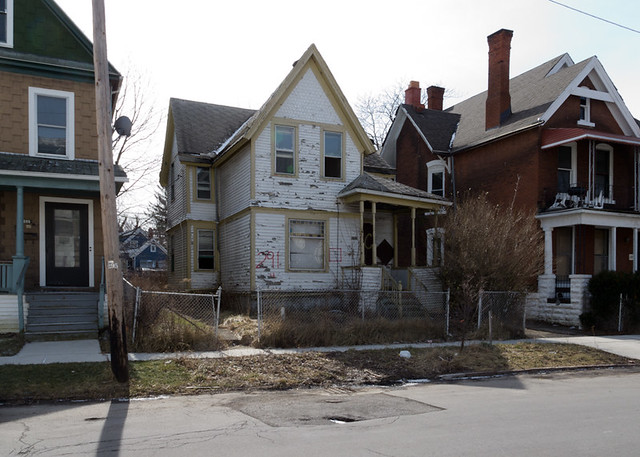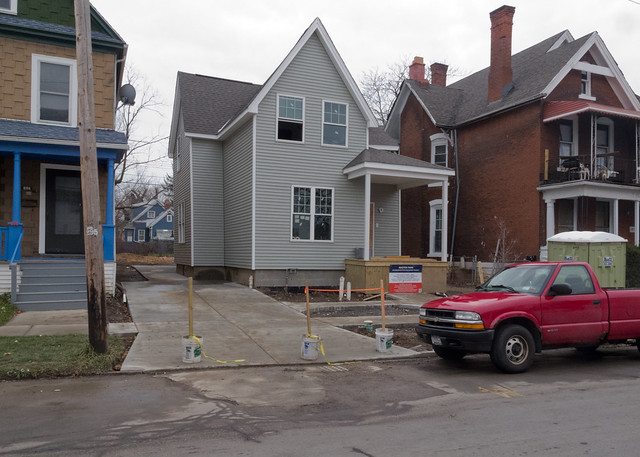 |
| 11 Holland Place before rehabilitation work. Note the intact architectural details |
I had some high hopes for the rehabilitation considering the
high price tag and the rich architectural details each home had. Unfortunately,
when going out for my “after” photos I was extremely disappointed.
 |
| 11 Holland Place after rehabilitation work and devoid of architectural details |
The homes had been stripped of their original architectural
integrity inside and outside. 11 Holland Place is one of the best examples; the
exterior featured clapboard in great shape, detailed wood porch columns, a
simple dentil cornice above three windows in the uppermost gable, and a
beautifully hand-carved motif in the porch pediment.
 |
| 11 Holland Place porch pediment before being scrapped |
Work during the rehabilitation scrapped every last one of
those details in favor of vinyl siding, the removal of the three windows in the
gable, and sending the porch columns and carved pediment to the trash. The
fireplace and pocket doors with ornate brass hardware have also been removed in
favor of a more “vanilla box” interior.
The same dull gray vinyl (likely bought in bulk), removal of
architectural details, and installation of vinyl windows repeats at the other
homes. At 144 Glenwood the Palladian window was removed in favor of a single
vinyl window, the bay window at the second story was removed for a flat wall,
and the full height pilasters at the corners have been removed or covered.
144 Glenwood Avenue: Before and After
Before the work started the homes were neglected, but
retained some rich architectural details, making it easy to identify them as
unique and varied structures. After the rehabilitation they are thankfully once
again livable, but almost indistinguishable from each other.
It’s an interesting contrast to the fantastic job Matt Newtonhas done at the Lyth Cottage on Harwood Place, especially when looking at the
cost. To date, Matt has spent about $30,000 on his home and put in a lot of
sweat equity. For that price, he has saved a beautiful home that was one its
way to the landfill just like these other homes.
While I understand not everyone has the time or is up to the
task to restore a home, a part of the problem is because the city does a poor
job of marketing available homes for sale. Each of these four homes was
previously owned by the city and available for purchase, but only if you knew
where to look. There was no sign on the lawn, nothing posted on the door, and
navigating the city website for information was a headache. For those who want
to learn more about purchasing a city-owned property, check out this great Buffalo blog,
Unbreak my House as a duo chronicle their story from start to finish and
how to get things done.
291 Northampton Street: Before and After
Longtime local blogger, David Torke (fixBuffalo) chimed in saying, “the concentration of development is
really exceptional and a good choice for the neighborhood. Renovating them is very important for the city at this time. The
question that remains is why the cost for rehab is so high, it remains unclear
why the rehabilitation of each property was specified at such a high cost.”
One reason that the cost is so high is because the jobs must be bid as prevailing wage jobs. A good chunk of the budget is spent on labor rather than materials. It is also likely most of those people doing the labor do not live in the adjacent neighborhood. While it’s great to have some historic homes back online and not in the landfill, it would be dangerous to repeat these types of rehabs too many times.
Those who appreciate architecture love Buffalo for the
varied styles and details that can be seen in our buildings on any given
street. Imagine if a whole street of homes were rehabilitated in such a manner,
the streetscape would become dull and uninteresting. I’m thankful these homes
will once again welcome families and be put on the tax rolls, but the end
product leaves a lot to be desired.
To see more before and after photos, click
the link to my Flickr page.
_________________________________________________________________________________________________




this is very sad. i was interested in 11 holland, had a tour with the real estate dept of the city and was then told it was not available because of a builder. i loved the architectural details of this home and am very sad to see them gone. this is not a "re-hab" this is a shame
ReplyDeleteI know how you feel. I had an interest in the same home and was in it several times before the "rehab." They essentially ruined it.
Deletei am just so confused. i thought protecting the architectural value was the first priority? 11 holland would have looked the very same as it did originally if the city would have let me do the "re-hab." the house is ruined. weird to say about what is "essentially" a "new" house, but the style does not fit in that neighborhood. given all the homes around it, 11 holland must look even worse when the surrounding homes are in view as well.
ReplyDeleteAre you still looking for a home to rehab in the same area? I have two that come to mind, one of which is detailed even better than Holland before the "rehab"
Deletepossibly, depends on the house. interested in finding a warehouse space now that i could have a loft living space for myself, and a business on the ground floor. always interested in architectural diamonds in the rough though
Deletedrock810@gmail.com
Thank you for the information.
ReplyDeleteRehabbed houses are sold at a higher prices because it is a flipped house.
I was actually confused about these things but i took a real estate class and sold Rehab House for profit. and now i work in real estates.